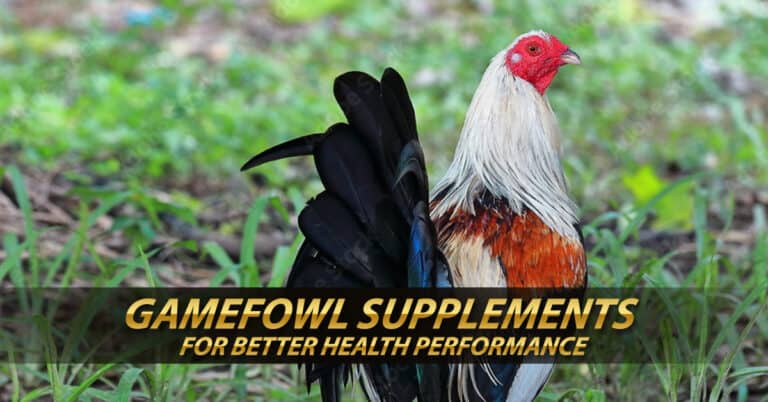Gamefowl Quarantine Procedure and Maintaining Winning Formula
Sabong International‘s concern for the health and welfare of your birds is probably a major consideration if you enjoy raising game birds. However, mycoplasma infection is one of the most prevalent and harmful health problems that gamefowl can have. Mycoplasma is a type of bacteria that can cause a variety of symptoms in birds, such as coughing, sneezing, nasal discharge, and decreased egg production. Mycoplasma infection can, in extreme circumstances, even be fatal.

Gamefowl Quarantine (Outside farm acquiring)
It’s crucial to put a variety of biosecurity measures in place to stop the spread of Mycoplasma and safeguard your birds’ health. The following are some essential actions you may take to protect your game birds from mycoplasma:

Supplements under Gamefowl Quarantine
It’s all about the health and performance of breed game birds. A properly balanced diet and a consistent supply of vitamins are necessary for achieving this. Your gamefowl’s nutrition and vitamins, which increase the fowl’s immunity and physical fitness, have a significant impact on how well they fight. Supplements are provided to the diet in the form of vitamins to make up for potential nutritional deficiencies. The fighting prowess of the gamefowl is also improved by this.
Electrogen D+
This water-soluble dietary supplement is designed to actively condition game birds. It functions similarly to an oral rehydration solution and includes electrolytes, glucose, and vital vitamins. After a battle or a particularly taxing training session, the gamefowls are given this combination to replenish and re-energize them.
One teaspoon of Electrogen D+ should be dissolved in a gallon of water to keep your gamefowl in peak fighting condition. When there is a disease epidemic or when you are engaged in intense training, give this every day. Use 2 tbsp of this in a gallon of water on days when there is a higher need for extra energy.
Ganador Max
This vitamin and mineral supplement, which comes in tablet form, is designed to help harden up corded gamefowl, reinforce the body, and improve fighting prowess. Ganador Max improves the immune system against common illnesses and the negative effects of stress in addition to fortifying the body for significant battles.
Give your gamefowl just 1 tablet every 3 days for pre-conditioning. This should be done till the conditioning period.

Thunderbird Dextrose Powder
To prevent gamefowl from becoming dehydrated during stressful times, this water-soluble supplement is available as dextrose powder. Consider getting vaccinated, recovering from a battle, recovering from a disease, or engaging in a demanding workout. The fighting cocks are revitalized and rehydrated by this supplement.
To feed your gamefowl, simply stir 1 tbsp of this powder into the food. This needs to be taken twice a day.
Thunderbird Energizer
On days when your gamefowl needs an extra push of energy, this quick energy booster delivers an additional dose. It is a liquid supplement that is great for fighting cocks while training, getting shots, or traveling.
Orally administer 7 drops at least 30 minutes before departure and 30 minutes after arrival.
Wow! Manok
This granule supplement is excellent for promoting quicker healing from illnesses, treating indigestion, and controlling the tension level in your game birds. It contains probiotics and prebiotics, both of which are primarily used to aid in better digestion. These are also necessary to make sure that the body is properly absorbing nutrients. Wow, that’s more significant! Manok also boosts the defense mechanisms of your game birds.
Simply combine 5g of Wow! Manok to a kilogram of feed. Give 1 capsule as a supplement, twice daily.
Gamefowls Maintaining Winning Formula
Maintaining a gamefowl’s health and ensuring that it moves through the seasons of its life smoothly are the first steps in ensuring its performance in the ring. It must first go through a set of pre-conditioning exercises before moving on to the conditioning stage. Let this quick read be your guide to maintaining and preconditioning gamefowl.
The Preconditioning & Maintenance Procedures for Gamefowl
Preconditioning for gamefowl is a crucial first step in conditioning. Your gamefowl’s care is gradually changing and improving, preparing them for more harsh environments and conditioning procedures.
The practices for gamefowl preconditioning include the following modifications:
Alterations in Feeding
The transition from pellets and grains to foods that are designed to get the chicken’s body and health ready for the conditioning-related exercise happens gradually. Which are:
Avoid abrupt feed changes because they could confuse the gamefowl. For additional minerals, feeds are occasionally fed to or tossed into the earth in chicken farms. Additionally, it teaches stags to look for food.
New Exercises & Activities
Gamefowl preconditioning introduces the exercises and activities that will be a part of the 21-day conditioning program. To reduce stress, an easy introduction is necessary. This can be accomplished by forming habits, such as practicing sparring regularly. Additionally, experts advise that activities like scratch box, running pen, and fly pen should be rotated healthily each week.
Wild Gamefowl Taming
Wild gamefowl training can be risky and challenging. Making sure that gamefowls are domesticated is a component of gamefowl preconditioning. The nightly brushing of a wild gamefowl’s feathers is a useful technique for taming it.
Regular Assistance or Gamefowl Maintenance
New rituals such as delousing, bacterial flushing, and worming will be required of stags. Once a month, these are completed. The following medicines can assist them in adjusting to the changes:
Buildings & Equipment
Make sure you have the tools you need to assist in conditioning your game birds. You require the structures and tools on the following list for preconditioning.
Conclusion
Findings emphasize the significance of promoting applied research to create long-term and customized biosecurity strategies for smallholder chicken flocks in low-income countries given the continuing threat of viruses to people in developing countries.










